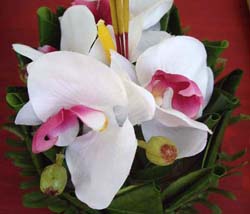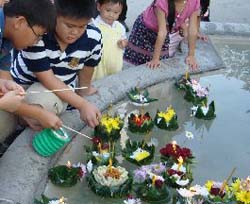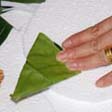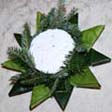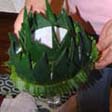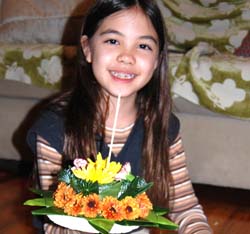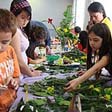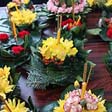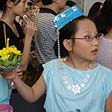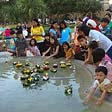Thai Customs of Loy Krathong
By Laura Westbrook
The tradition of making the krathong, or floating lotus, is maintained by a handful of Louisiana residents of Thai lineage. Made of banana and other leaves and flowers set into a round base about 8 inches across and 1 to 2 inches thick, and bearing incense, candles, and sometimes additional decorations or charms, they are the primary feature of the Thai Loy Krathong, the Festival of the Floating Lotus. The annual event falls on the night when the tides are at their highest and the moon at its brightest-the full moon night of the 12th lunar month, which is usually in mid-November.
The riverside festival is celebrated in communities throughout Thailand, but it is not a national holiday. In the evening, people send their hand-made or purchased krathongs (translates roughly as "floating basket") down the river after lighting the candles and incense and making a wish for the coming year. It is said that the wish will come true if the candle remains lit until the basket passes out of sight, and also that the longer the candle remains lit the better the coming year will be. The festival is also considered to be a particularly romantic occasion. Lovers set their krathongs into the water side by side; if the baskets remain together as they float down the river, it is considered an omen that the couple will remain together as well. For this reason as well as the romance of the setting, some compare it to Valentine's Day, but it is also an intergenerational family and community event that can last several days.
The sight of thousands of flickering candle-lit, and beautifully-decorated, floral baskets floating en masse down the river, which shimmers in turn with dancing light and shadows, is a powerful memory of home for Louisiana residents who have emigrated from Thailand. Its aspect as a shared experience is of great importance; many provinces have their own traditions, but Loy Krathong is a memory that all Thai people in new countries have in common. The primary components of the festival are the same all over the country-days spent with friends and family making and decorating the krathongs; gatherings of loved ones at the water's edge; children staying up late with their families; special picnic foods; prayers acknowledging past mistakes and setting higher goals for the future; and special appreciation of the natural world.
In larger provinces such as Sukhothai, Chiang Mai, Ayutthaya and Bangkok, the festivities may include a parade with elaborate floats that rival those of carnival in New Orleans, beauty contests, and the release of khom loy (small handcrafted paper lanterns that float on the air like hot-air balloons) into the sky. At large and smaller celebrations across the country, participants enjoy fireworks, music and dancing, and dinner purchased from riverside stalls. Two songs that are commonly sung on this day can be translated approximately like this:
On the full moon day of the 12th lunar month
Water overflows the banks.
All of us, both boys and girls,
Will have fun together on Loi Krathong Day!
Loi, Loi Krathong...Loi, Loi Krathong
When we've floated our krathongs
We'll ask Nawng Gaew to come out and dance the ramwong [folk dance]
Dance the ramwong on Loi Krathong Day
Dance the ramwong on Loi Krathong Day
Earning merit will bring us happiness.
Earning merit will bring us happiness.
November full moon shines,
Loy Krathong, Loy Krathong,
and the water's high in the river and local klong {canal],
Loy Loy Krathong, Loy Loy Krathong,
Loy Krathong is here and everybody's full of cheer,
We're together at the klong,
Each one with his krathong,
As we push away we pray,
We can see a better day.
As is not uncommon with folk crafts and festivals, the event's origin is obscure. It is variously said to be Buddhist or Hindu, a celebration of the end of the rainy season, or a general homage to one's ancestors and the good things of life, begun long before the event was first recorded. The theme that most stories share is that of recognizing the value and importance of water to the lives of the Thai people, the cleansing of sins or bad luck, and the annual renewal of life and hope.
Krathongs made in the New Orleans area are similar to those traditionally made in Thailand, except that Styrofoam may now be used as the base rather than the cross-section of a banana tree. To this base, between 6 and 10 inches across, is affixed banana or other leaves, folded and attached to make the entire base resemble a stylized lotus flower. Depending on the mood and vision of the artist, several more layers of leaves may be added to create a ruffled appearance around the outer edge. Flowers and other decorations are placed inside the leaves, usually forming circles within circles of harmonious colors. Finally, candles and incense sticks, and sometimes small token offerings to the river spirit, are inserted into the center.
As of 2008, no Festival of the Floating Lotus has been celebrated in Louisiana, though this is a goal for some Louisiana Thais. However, in 2007 a group of children of Asian heritage, as part of a holiday party held to teach children about their cultural traditions, learned to make the krathong. The party was sponsored by the Asian Pacific American Society, which invited Asian families and also blended families comprising Asian adopted children of non-Asian parents, and was held at Loyola University's Danna Center. After the children made their floating lotus, they walked as a group to Audubon Park and released them in the water.
The children were taught to make the krathongs by Wimol Harwell, Jenjira Wilson, and Jenjira's daughter Tania Wilson. In the fall of 2007 and of 2008, Wimol Harwell and Jenjira Wilson visited with folklorist Laura Westbrook. They spoke about learning and sharing this tradition, and demonstrated how krathongs are made. According to Wimol Harwell,
The Loy Krathong has many conflicting explanations of its purposes. It is the end of the rainy season; it is a celebration of the end of rice planting; it is an act of repentance for dirtying the river, an act of homage to the river goddess [Mae Khrong-Kha], or worship of the heavens generally. It is a way of ridding oneself of bad luck or the accumulated sins of the year past. It is also another reason for fun-loving in the Thai way as it has been done since the 13th Century.
I grew up in Phayao Province in the northern part of Thailand. Before Phayao was a part of Thailand, it was part of the Lanna Kingdom. Northern Thailand is where Thailand's second largest city (Chaing Mai) and third largest city (Chang Rai) are located. I lived in a rural area where many people still farm for a living.
My mother began to teach me how to make the krathongs when I was five or six years old. It is important to me because I love the traditions and culture of where I come from. I do not want to lose our traditions, and I want to be able to show people these days. I think people have a lot to learn from each other. I would like to maintain our traditions for the future.
[Making the krathongs] means a lot to me now, because it reminds me of when I was young. Even though I am here in the USA, I can still make the krathongs float and remember Thailand. I can feel connected to my original home. It is like a trip back to Thailand. I think about what is happening in Thailand at this time of year. We know it is finished when it is beautiful. A good krathong is one that appeals to your eye. When people put their krathongs in the river, they are supposed to make a wish. I always wished to meet Mr. Right.
On teaching the craft to children and others:
I like the look on people's faces when they make something really beautiful for the first time. It is totally different than anything that they are used to, so people get very interested in the krathong. That makes me feel good about being from Thailand.
Adds Jenjira Wilson,
I grew up in a small village, Ban Mai Num Yen, south of Chiang Rai, Thailand. This place was the birthplace of the krathong. At first, I watched other people who already knew about krathong. Later on I asked them to teach me.
Sometimes my friends and I shared ideas with each other and that is how I learned. I remember that every November during the evening, family members and friends would get together and make krathongs. Back then, we used bananas leaves and folded them into the leaves, cup-shaped, and attached them around the side of base. For the base, we cut the trunk of banana tree [sliced into round sections] about three inches thick.
Thai people called [the holiday] Loy Krathong. "Loy" is mean "to float" in English. At night on November 12th we went to the local river bank to float our krathong. It is a Thai tradition; we believe that floating the krathong is to send away a bad wish, to wish for good luck, to wish for good health, any wishes. Most of all, I liked this particular [holiday], Loy Krathong, because I have a chance to meet friends and family [who] came to gather and celebrate under the full moon light. It was also the sight of the candles' light. There, people would sing a song of Loy Krathong. Some people would dance in a free style with their hand holding their krathong. When I am thinking of Loy Krathong, I think it was a fun event back at my home town. I can hear the sound of laughing echo in my mind.
I first started to introduce making krathongs at APAS (Asian Pacific American Society) organization festival at the Audubon Zoo (the annual Asian Heritage Festival held in April). There were many adults and young kids who came and they enjoyed it. I believe that kids today like to create things. Kra-thong is also a way for kids to challenge their little hands. While they are making a kra-thong, their mind is focusing. They think of beautiful objects to decorate a kra-thong. When they needed my advice they will ask some questions. They will ask "Am I folding it right?," "How many leaves do I have to pick?," "Can you help me with this?," "Am I done yet?," "Whoa, I like this flower," "What I have to do next?" "This is my favorite color." I like all these questions and I feel that they enjoy doing it. Some kids like to show their own idea, and this works, too. I feel that this is a wonderful activity and at the same time kids learn to express themselves.
Even though Loy Kra-thong is related to Thai culture, that doesn't mean other people can't be part of it. That [is] why I like to introduce kra-thong making to whoever [is] interested. Now I am living in USA. I am still carrying part of my tradition even though [it is] not exactly the same. Nevertheless many of you are helping me by joining in making the kra-thong. It is reminding me feel like back home.
A number of Thai residents in the greater New Orleans region would like to expand their seasonal cultural practices beyond the making of krathongs to include a ceremony during which the krathongs would be released into a suitable body of water, and perhaps this would include music, dance, and festive foods. The festival in Thailand is making efforts to "go green," with people cleaning the waters and shores afterward as is appropriate for an event that honors waterways and the water goddess, so this follow-up activity could easily be incorporated into a new event in the New Orleans area. For the time being, visitors to the annual Asian Heritage Festival can view and create krathongs, and visit with their Thai neighbors who can tell them more about Thai culture and customs (May 9, 2009, New Orleans' Audubon Park Zoo, details on http://www.apasneworleans.com/). Jenjira and Wimol will also demonstrate their craft process at the July 2009 NSU Folk Festival in Natchitoches, Louisiana.
Note: There is no generally accepted English-language spelling for the word "krathong." This spelling is the most commonly used, so it is used here. Wimol Harwell spells it "khratong;" and Jenjira Wilson uses "kra-thong;" others use "gratong." Probably others have still more phonetic translations. "Loi" and "Loy" are also used interchangeably.


